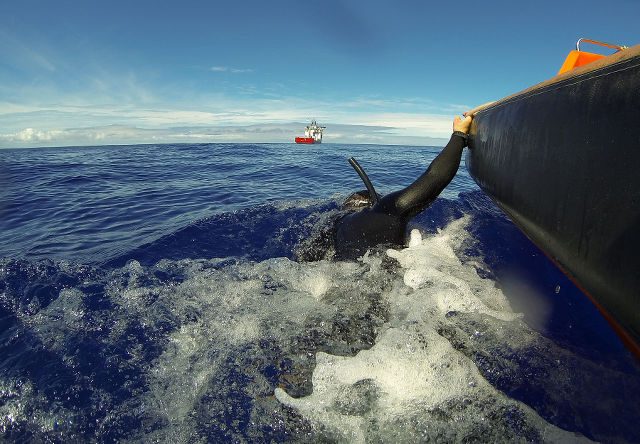SUMMARY
This is AI generated summarization, which may have errors. For context, always refer to the full article.

PERTH, Australia – Ships listening for underwater signals from Flight MH370 have logged no more “pings” and will spend several more days trying to pinpoint a crash site before a mini-sub is launched to scour the seabed, searchers say.
A month to the day since the Boeing 777 vanished with 239 people on board, time is running out to detect further signals as the batteries in beacons on the jet’s black box data recorders reach their expiry date.
Transmissions picked up by Australia’s Ocean Shield naval ship – consistent with those from aircraft black boxes – had raised hopes that a robotic submersible would soon be sent down to look for debris.
But search chief Angus Houston clarified Tuesday that while the pings were an exciting development, further transmissions were needed before deploying the mini-sub.
“We need to continue that (search) for several days to the point at which there is absolutely no doubt that the pinger batteries will have expired,” Houston said.
“Until we stop the pinger search we will not deploy the submersible.”
He said no further transmissions had been detected in the remote search area off western Australia which could help pinpoint where the jet might have crashed.
It went missing en route from Kuala Lumpur to Beijing on March 8 and the search is now focusing on a 600-kilometer (370-mile) arc of the remote southern Indian Ocean.
Houston had indicated that the time was nearing for the Ocean Shield, which is criss-crossing the area to try to home in on the signals again, to launch the US-made autonomous underwater vessel Bluefin-21.
But he spelt out a more definitive timeframe Tuesday, saying the five-metre-long (16-feet) submersible sonar device would not be put into the water until the pinger search has ended.
“If we go down there now and do the visual search it will take many, many, many days because it’s very slow, very painstaking work to scour the ocean floor,” he said.
Once in the water, if the mini-sub detects something unusual with its sonar, it can be brought to the surface and sent down again equipped with a video camera to provide visual evidence of a crash.
Families of MH370 passengers in Beijing marked the one-month anniversary with a tearful candlelit vigil Tuesday, desperately trying to comfort each other as the agonising wait to locate the plane continues.
“We’ve been waiting and holding on here for already 31 days,” said Steve Wang, one of the relatives.
About two-thirds of the 239 people on board were Chinese.
Taking it to the limit
The 4.5-kilometer (nearly 3-mile) depth of the ocean floor is the absolute operating limit for a Bluefin-21, which is designed for deep sea surveying and can carry video cameras.
Ocean Shield, which picked up two series of pulses lasting two hours and 20 minutes and then 13 minutes, is operating at the northern end of the defined search area.
China’s Haixun 01, which has also reported some acoustic sounds, and Britain’s HMS Echo are working the southern end.
Houston said the Ocean Shield transmissions were the most promising, adding that the advice from black box manufacturers was that the frequency of the signals could have changed.
“There’s a change with the pressure on the ocean floor and the age of the particular batteries… you get changes in the transmission level,” he said.
“Some of the false leads that we’ve had have been transmissions from the ship that was actually searching.”
Encouraging signs
While 14 ships were involved in the search, it was not possible to crowd the area due to the need for silence, he said.
“We can’t have too many ships in the area because when you’re dealing with these transmissions you need utter silence,” he said.
Commander William Marks of the US Seventh Fleet has said one of the signals strengthened for a time and then weakened, indicating crews were near its source.
“That is encouraging because that is what you would expect if you are indeed moving toward the black box — that it should get stronger and as you move away from it, it should get weaker,” he told the Agence France-Presse.
Up to 11 military planes and 3 civilian planes were also Tuesday set to take part in the unprecedented search 2,268 kilometers northwest of Perth, the Joint Agency Coordination Centre said. – Rappler.com
Add a comment
How does this make you feel?
There are no comments yet. Add your comment to start the conversation.